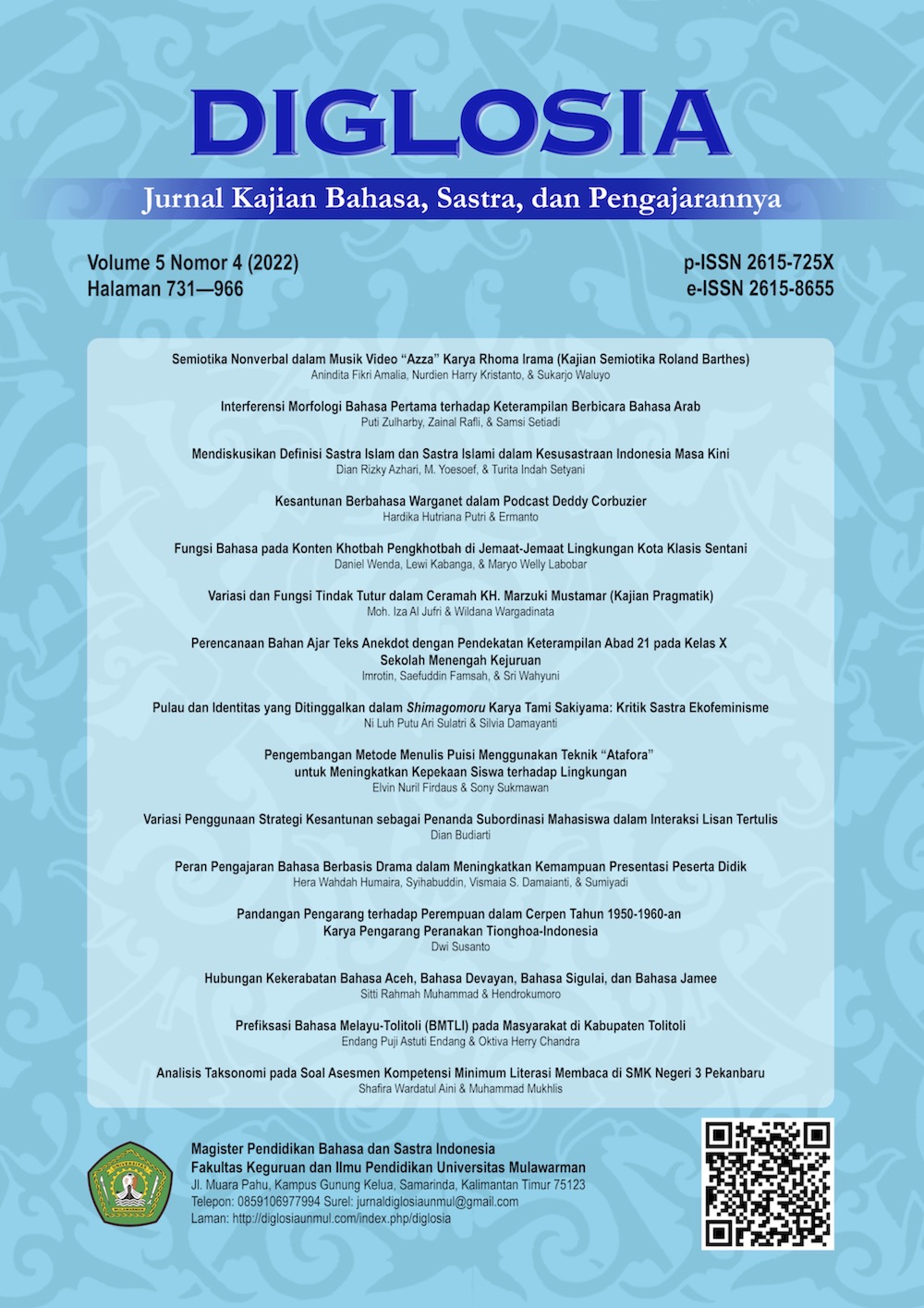Peran Pengajaran Bahasa Berbasis Drama dalam Meningkatkan Kemampuan Presentasi Peserta Didik
Main Article Content
Abstract
This study aimed to study the effect of drama-based language teaching on students' presentation skills in college. This study used a quasi-experimental method by dividing two groups of participants, namely experimental and control. The samples involved in this study were 100 students from semester 5, divided into 2 groups with the composition of each group of 50 students. The experimental group received a drama-based teaching intervention and was assigned to perform live drama at the end of the semester, while the control group did not. The research results show that drama-based language teaching contributes significantly to students' presentation skills. The improvement in presentation skills is seen in the presentation aspect, namely organization, adaptability, and presentation content. It can be concluded that the intervention of language teaching through drama can improve students' oral language skills or presentation skills. This study implies that in supporting academic activities, students' speaking skills can use drama as an alternative, especially for students who take language studies programs.
Downloads
Article Details
![]()
Every work in Diglosia: Jurnal Kajian Bahasa, Sastra, dan Pengajarannya is licensed under a Creative Commons Attribution-ShareAlike 4.0 International License.
Under the following terms:
- Attribution — You must give appropriate credit , provide a link to the license, and indicate if changes were made . You may do so in any reasonable manner, but not in any way that suggests the licensor endorses you or your use.
- ShareAlike — If you remix, transform, or build upon the material, you must distribute your contributions under the same license as the original.
- No additional restrictions — You may not apply legal terms or technological measures that legally restrict others from doing anything the license permits.
Authors who publish with this journal agree to the following terms:
- Authors retain copyright and grant the journal right of first publication with the work simultaneously licensed under a CC BY-SA 4.0 DEED Attribution-ShareAlike 4.0 Internationalthat allows others to share the work with an acknowledgment of the work's authorship and initial publication in this journal.
- Authors are able to enter into separate, additional contractual arrangements for the non-exclusive distribution of the journal's published version of the work (e.g., post it to an institutional repository or publish it in a book), with an acknowledgment of its initial publication in this journal.
- Authors are permitted and encouraged to post their work online (e.g., in institutional repositories or on their website) prior to and during the submission process, as it can lead to productive exchanges, as well as earlier and greater citation of published work.
References
Biebricher, C., East, M., Howard, J., & Tolosa, C. (2019). Navigating Intercultural Language Teaching in New Zealand Classrooms. Cambridge Journal of Education, 49(5), 605–621. https://doi.org/10.1080/0305764X.2019.1581137
Bygate, M. (2016). Sources, Developments and Directions of Task-based Language Teaching. The Language Learning Journal, 44(4), 381–400. https://doi.org/10.1080/09571736.2015.1039566
Chi, X.-B., Belliveau, G., & Dong, B.-F. (2021). Looking Back and Looking Forward: Educational Drama in Chinese Language Arts Education. Research in Drama Education: The Journal of Applied Theatre and Performance, 26(2), 312–317. https://doi.org/10.1080/13569783.2021.1901568
Colliander, H., & Fejes, A. (2021). The Re-emergence of Suggestopedia: Teaching a Second Language to Adult Migrants in Sweden. Language, Culture and Curriculum, 34(1), 51–64. https://doi.org/10.1080/07908318.2020.1767643
Gibson, R. (2015). The School Drama Program: Delivering Process Drama via a Teaching Artist. NJ, 39(1), 76–95. https://doi.org/10.1080/14452294.2015.1083152
Hadianto, D., Damaianti, V. S., Mulyati, Y., & Sastromiharjo, A. (2021). Enhancing Scientific Argumentation Skill through Partnership Comprehensive Literacy. Journal of Physics: Conference Series, 2098. https://doi.org/10.1088/1742-6596/2098/1/012015
Hadianto, D., S. Damaianti, V., Mulyati, Y., & Sastromiharjo, A. (2022). Effectiveness of Literacy Teaching Design Integrating Local Culture Discourse and Activities to Enhance Reading Skills. Cogent Education, 9(1), 0–13. https://doi.org/10.1080/2331186X.2021.2016040
Hulse, B., & Owens, A. (2019). Process Drama as a Tool for Teaching Modern Languages: Supporting the Development of Creativity and Innovation in Early Professional Practice. Innovation in Language Learning and Teaching, 13(1), 17–30. https://doi.org/10.1080/17501229.2017.1281928
Kalogirou, K., Beauchamp, G., & Whyte, S. (2019). Vocabulary Acquisition via Drama: Welsh as a Second Language in the Primary School Setting. The Language Learning Journal, 47(3), 332–343. https://doi.org/10.1080/09571736.2017.1283351
Korkut, P. (2018). The Construction and Pilot Application of a Scoring Rubric for Creative Drama Lesson Planning. Research in Drama Education: The Journal of Applied Theatre and Performance, 23(1), 114–125. https://doi.org/10.1080/13569783.2017.1396211
Korkut, P., & Çelik, Ö. (2021). Developing Pronunciation through Creative Drama. The Language Learning Journal, 49(2), 147–159. https://doi.org/10.1080/09571736.2018.1491058
Lida, U. M. (2022). Struktur Isi Argumen dalam Teks Argumentasi Siswa Tahap Operasi Formal. Diglosia: Jurnal Kajian Bahasa, Sastra, Dan Pengajarannya, 5(2), 377–388. https://doi.org/10.30872/diglosia.v5i2.318
Minas, E. C. (2020). The Affordances Theory in Teaching and Learning African First Additional Languages: A Case for Task-based Language Teaching. Southern African Linguistics and Applied Language Studies, 38(1), 1–15. https://doi.org/10.2989/16073614.2019.1698303
Rofi’uddin, A. H., Susanto, G., Widyartono, D., Sultan, S., & Muzakki, H. (2022). Pengembangan Pembelajaran Berpikir Kritis-Kreatif Berbasis Blended Learning di SMA. Diglosia: Jurnal Kajian Bahasa, Sastra, Dan Pengajarannya, 5(2), 527–536. https://doi.org/10.30872/diglosia.v5i2.414
Schenker, T. (2020). Fostering Foreign Language Skills through an Extracurricular Drama Project. The Language Learning Journal, 48(6), 785–798. https://doi.org/10.1080/09571736.2017.1406532
Sitorus, N., & Mulyadi, M. (2022). Konstruksi Aplikatif Bahasa Indonesia. Diglosia: Jurnal Kajian Bahasa, Sastra, Dan Pengajarannya, 5(3), 631–640. https://doi.org/10.30872/diglosia.v5i3.431
Thibault, L. V. (2020). Theatre of the Oppressed in French as a Second language. Language and Intercultural Communication, 0(0), 312–324. https://doi.org/10.1080/14708477.2020.1788048
Thorkelsdóttir, R. B. (2020). The Complex Role of Drama Teaching and Drama Teachers’ Learning Trajectories in an Icelandic Context. Research in Drama Education: The Journal of Applied Theatre and Performance, 25(4), 593–612. https://doi.org/10.1080/13569783.2020.1796615
Trent, J. (2014). Innovation as Identity Construction in Language Teaching and Learning: Case Studies from Hong Kong. Innovation in Language Learning and Teaching, 8(1), 56–78. https://doi.org/10.1080/17501229.2012.750664
Wu, M. (2016). Implications of Hegel’s Theories of Language on Second Language Teaching. Journal of Curriculum Studies, 48(3), 346–366. https://doi.org/10.1080/00220272.2016.1151081

